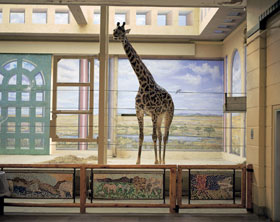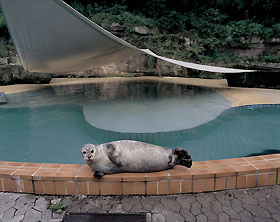For more archives, go to the Advance Archive/Search Page.
Zoo Animals' Dignity, Isolation
Depicted In Art Professor's Book
The black, almond-shaped eyes of a seal peer languorously through its tank; a somber hippopotamus dolefully approaches a shallow pool of murky water; a perplexed penguin stares blankly at a painted arctic landscape.
These are just a few of the images captured in Frank Noelker's Captive Beauty, published this summer.
 |
Photographs of a giraffe and a seal are among the poignant images of zoo animals
from the around the world in Frank Noelker's book, Captive Beauty.
|
 |
Ten years in the making, the fine arts professor's photography book shows images of animals in zoo settings. Noelker visited more than 300 locations, including zoos in France, Germany, the Netherlands, and Brazil, as well as Los Angeles, New York, San Diego, Memphis, and Washington, DC.
Noelker spent days and nights with zoo animals until he felt he obtained just the right images that reflected not only the great dignity of the animals, but also their loneliness and isolation. He says the zoos and his photographs really reflect human society.
Although the photos speak for themselves, they've elicited glowing responses from many, including primatologist Jane Goodall and author and animal expert Nigel Rothfels.
"Frank Noelker's work makes a powerful statement," Goodall says in the book's foreword. "It is both beautiful and profoundly disturbing. He has captured, in this series of portraits, the very essence of the problem of zoos . This book is not intended as an indictment of all zoos, but rather as a plea for greater understanding of the animal beings within them."
In the introduction, Rothfels comments, "The animals in Frank Noelker's photographs ask us to see them in their lived environment. They challenge us to think about why we go to zoos and why we think such places should exist or not. The answers to these questions are individual and complex - but asking them is the most critical part of being the humans at the zoo."
Noelker says the years he spent visiting zoos around the world and taking the photos had a deep, personal effect on him. "It hurts," he says, "knowing that you are photographing someone else's misery."
Noelker's photographs have been featured in many solo and group exhibitions, and are a part of the permanent collection at several museums.

